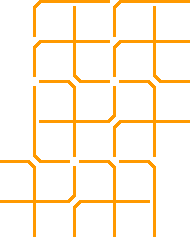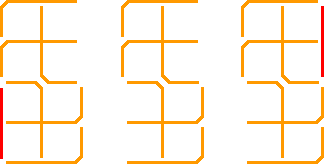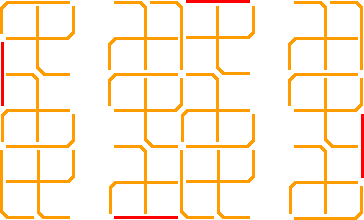




| n \ m | 0 | 1 | 2 | 3 | |||||||||||||||||||||||||||||||||||||
|---|---|---|---|---|---|---|---|---|---|---|---|---|---|---|---|---|---|---|---|---|---|---|---|---|---|---|---|---|---|---|---|---|---|---|---|---|---|---|---|---|---|
| 0 | 0 / 0 | ||||||||||||||||||||||||||||||||||||||||
| 1 | φ | φ
| 2 | 1 / 1 | 4 / 8 | 6 / 18
| 3 | φ | φ | 9 / 31 | 17 / 46 | (BH/AS) 4 | 2 / 2 | φ | 5 / 44 | (EF/DB) ?
| 5 | φ | 14 / 20 | 8 / 47 | ?
| 6 | 3 / 3 | φ | 10 / 57 | ?
| 7 | φ | 16 / 34 | 13 / 70 | ?
| 8 | 4 / 4 | 21 / 27 | 15 / 87 | ?
| 9 | φ | 20 / 48 | 18 / 90 | ?
| |
Anti Solg and Bruce Herdt sent many 3×3 grids.
Luke Pebody showed that the smallest totals for large 1×n grids depend on n mod 3, and that the largest totals for large 1×n grids depend on n mod 2:




 |
Richard Sabey gave this small total tiling:
x(4n+2).gif) |
Luke Pebody found this group of 7's that tiles the plane, giving him hope that for large m×n grids, a total on the order of 7(2mn+m+n)/3 is possible:
 |
David Bevan found the largest totals for 2n×4 and 4n×6 grids:

 |
The 0×n solutions are trivial. Here are the known 1×n solutions for small n:
|
|
|
|
|
Luke Pebody gave a full analysis of the 1×n possibilities, essentially agreeing with the following directed graph of mine:

Here are the known 2×n solutions for small n:
|
|
If you can extend any of these results, please e-mail me. Click here to go back to Math Magic. Last updated 8/12/08.